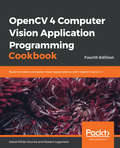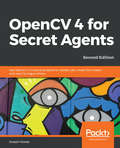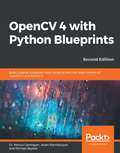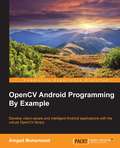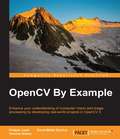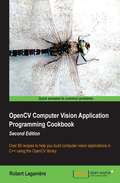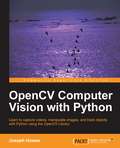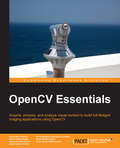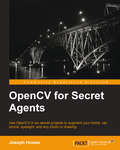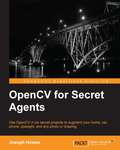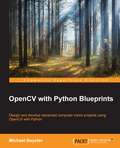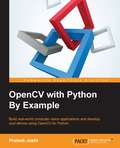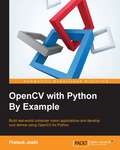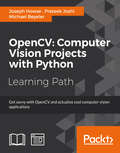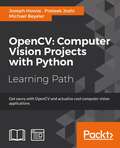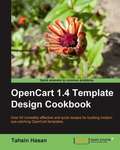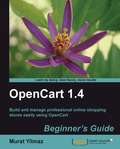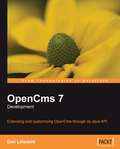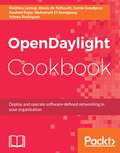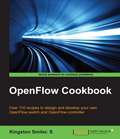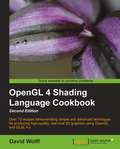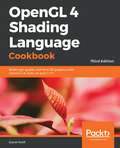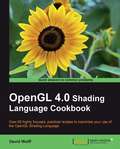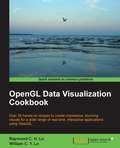- Table View
- List View
OpenCV 4 Computer Vision Application Programming Cookbook: Build complex computer vision applications with OpenCV and C++, 4th Edition
by Robert Laganiere David Millán EscriváDiscover interesting recipes to help you understand the concepts of object detection, image processing, and facial detectionKey FeaturesExplore the latest features and APIs in OpenCV 4 and build computer vision algorithmsDevelop effective, robust, and fail-safe vision for your applicationsBuild computer vision algorithms with machine learning capabilitiesBook DescriptionOpenCV is an image and video processing library used for all types of image and video analysis. Throughout the book, you'll work through recipes that implement a variety of tasks, such as facial recognition and detection. With 70 self-contained tutorials, this book examines common pain points and best practices for computer vision (CV) developers. Each recipe addresses a specific problem and offers a proven, best-practice solution with insights into how it works, so that you can copy the code and configuration files and modify them to suit your needs.This book begins by setting up OpenCV, and explains how to manipulate pixels. You'll understand how you can process images with classes and count pixels with histograms. You'll also learn detecting, describing, and matching interest points. As you advance through the chapters, you'll get to grips with estimating projective relations in images, reconstructing 3D scenes, processing video sequences, and tracking visual motion. In the final chapters, you'll cover deep learning concepts such as face and object detection.By the end of the book, you'll be able to confidently implement a range to computer vision algorithms to meet the technical requirements of your complex CV projectsWhat you will learnInstall and create a program using the OpenCV librarySegment images into homogenous regions and extract meaningful objectsApply image filters to enhance image contentExploit image geometry to relay different views of a pictured sceneCalibrate the camera from different image observationsDetect people and objects in images using machine learning techniquesReconstruct a 3D scene from imagesExplore face detection using deep learningWho this book is forIf you’re a CV developer or professional who already uses or would like to use OpenCV for building computer vision software, this book is for you. You’ll also find this book useful if you’re a C++ programmer looking to extend your computer vision skillset by learning OpenCV.
OpenCV 4 for Secret Agents: Use OpenCV 4 in secret projects to classify cats, reveal the unseen, and react to rogue drivers, 2nd Edition
by Joseph HowseTurn futuristic ideas about computer vision and machine learning into demonstrations that are both functional and entertainingKey FeaturesBuild OpenCV 4 apps with Python 2 and 3 on desktops and Raspberry Pi, Java on Android, and C# in UnityDetect, classify, recognize, and measure real-world objects in real-timeWork with images from diverse sources, including the web, research datasets, and various camerasBook DescriptionOpenCV 4 is a collection of image processing functions and computer vision algorithms. It is open source, supports many programming languages and platforms, and is fast enough for many real-time applications. With this handy library, you’ll be able to build a variety of impressive gadgets.OpenCV 4 for Secret Agents features a broad selection of projects based on computer vision, machine learning, and several application frameworks. To enable you to build apps for diverse desktop systems and Raspberry Pi, the book supports multiple Python versions, from 2.7 to 3.7. For Android app development, the book also supports Java in Android Studio, and C# in the Unity game engine. Taking inspiration from the world of James Bond, this book will add a touch of adventure and computer vision to your daily routine. You’ll be able to protect your home and car with intelligent camera systems that analyze obstacles, people, and even cats. In addition to this, you’ll also learn how to train a search engine to praise or criticize the images that it finds, and build a mobile app that speaks to you and responds to your body language.By the end of this book, you will be equipped with the knowledge you need to advance your skills as an app developer and a computer vision specialist.What you will learnDetect motion and recognize gestures to control a smartphone gameDetect car headlights and estimate their distanceDetect and recognize human and cat faces to trigger an alarmAmplify motion in a real-time video to show heartbeats and breathsMake a physics simulation that detects shapes in a real-world drawingBuild OpenCV 4 projects in Python 3 for desktops and Raspberry PiDevelop OpenCV 4 Android applications in Android Studio and UnityWho this book is forIf you are an experienced software developer who is new to computer vision or machine learning, and wants to study these topics through creative projects, then this book is for you. The book will also help existing OpenCV users who want upgrade their projects to OpenCV 4 and new versions of other libraries, languages, tools, and operating systems. General familiarity with object-oriented programming, application development, and usage of operating systems (OS), developer tools, and the command line is required.
OpenCV 4 with Python Blueprints: Build creative computer vision projects with the latest version of OpenCV 4 and Python 3, 2nd Edition
by Michael Beyeler Dr. Menua Gevorgyan Arsen MamikonyanGet to grips with traditional computer vision algorithms and deep learning approaches, and build real-world applications with OpenCV and other machine learning frameworks Key Features Understand how to capture high-quality image data, detect and track objects, and process the actions of animals or humans Implement your learning in different areas of computer vision Explore advanced concepts in OpenCV such as machine learning, artificial neural network, and augmented reality Book Description OpenCV is a native cross-platform C++ library for computer vision, machine learning, and image processing. It is increasingly being adopted in Python for development. This book will get you hands-on with a wide range of intermediate to advanced projects using the latest version of the framework and language, OpenCV 4 and Python 3.8, instead of only covering the core concepts of OpenCV in theoretical lessons. This updated second edition will guide you through working on independent hands-on projects that focus on essential OpenCV concepts such as image processing, object detection, image manipulation, object tracking, and 3D scene reconstruction, in addition to statistical learning and neural networks. You'll begin with concepts such as image filters, Kinect depth sensor, and feature matching. As you advance, you'll not only get hands-on with reconstructing and visualizing a scene in 3D but also learn to track visually salient objects. The book will help you further build on your skills by demonstrating how to recognize traffic signs and emotions on faces. Later, you'll understand how to align images, and detect and track objects using neural networks. By the end of this OpenCV Python book, you'll have gained hands-on experience and become proficient at developing advanced computer vision apps according to specific business needs. What you will learn Generate real-time visual effects using filters and image manipulation techniques such as dodging and burning Recognize hand gestures in real-time and perform hand-shape analysis based on the output of a Microsoft Kinect sensor Learn feature extraction and feature matching to track arbitrary objects of interest Reconstruct a 3D real-world scene using 2D camera motion and camera reprojection techniques Detect faces using a cascade classifier and identify emotions in human faces using multilayer perceptrons Classify, localize, and detect objects with deep neural networks Who this book is for This book is for intermediate-level OpenCV users who are looking to enhance their skills by developing advanced applications. Familiarity with OpenCV concepts and Python libraries, and basic knowledge of the Python programming language are assumed.
OpenCV Android Programming By Example
by Amgad MuhammadDevelop vision-aware and intelligent Android applications with the robust OpenCV libraryAbout This BookThis is the most up-to-date book on OpenCV Android programming on the market at the moment. There is no direct competition for our title.Based on a technology that is increasing in popularity, proven by activity in forums related to this topic.This book uniquely covers applications such as the Panoramic viewer and Automatic Selfie, among others.Who This Book Is ForIf you are an Android developer and want to know how to implement vision-aware applications using OpenCV, then this book is definitely for you.It would be very helpful if you understand the basics of image processing and computer vision, but no prior experience is requiredWhat You Will LearnIdentify and install all the elements needed to start building vision-aware Android applicationsExplore image representation, colored and gray scaleRecognize and apply convolution operations and filtering to deal with noisy dataUse different shape analysis techniquesExtract and identify interest points in an imageUnderstand and perform object detectionRun native computer vision algorithms and gain performance boostsIn DetailStarting from the basics of computer vision and OpenCV, we'll take you all the way to creating exciting applications. You will discover that, though computer vision is a challenging subject, the ideas and algorithms used are simple and intuitive, and you will appreciate the abstraction layer that OpenCV uses to do the heavy lifting for you. Packed with many examples, the book will help you understand the main data structures used within OpenCV, and how you can use them to gain performance boosts. Next we will discuss and use several image processing algorithms such as histogram equalization, filters, and color space conversion. You then will learn about image gradients and how they are used in many shape analysis techniques such as edge detection, Hough Line Transform, and Hough Circle Transform. In addition to using shape analysis to find things in images, you will learn how to describe objects in images in a more robust way using different feature detectors and descriptors.By the end of this book, you will be able to make intelligent decisions using the famous Adaboost learning algorithm.Style and approachAn easy-to-follow tutorial packed with hands-on examples. Each topic is explained and placed in context, and the book supplies full details of the concepts used for added proficiency.
OpenCV By Example
by Prateek Joshi David Millan Escriva Vinicius GodoyEnhance your understanding of Computer Vision and image processing by developing real-world projects in OpenCV 3 About This Book * Get to grips with the basics of Computer Vision and image processing * This is a step-by-step guide to developing several real-world Computer Vision projects using OpenCV 3 * This book takes a special focus on working with Tesseract OCR, a free, open-source library to recognize text in images Who This Book Is For If you are a software developer with a basic understanding of Computer Vision and image processing and want to develop interesting Computer Vision applications with Open CV, this is the book for you. Knowledge of C++ is required. What You Will Learn * Install OpenCV 3 on your operating system * Create the required CMake scripts to compile the C++ application and manage its dependencies * Get to grips with the Computer Vision workflows and understand the basic image matrix format and filters * Understand the segmentation and feature extraction techniques * Remove backgrounds from a static scene to identify moving objects for video surveillance * Track different objects in a live video using various techniques * Use the new OpenCV functions for text detection and recognition with Tesseract In Detail Open CV is a cross-platform, free-for-use library that is primarily used for real-time Computer Vision and image processing. It is considered to be one of the best open source libraries that helps developers focus on constructing complete projects on image processing, motion detection, and image segmentation. Whether you are completely new to the concept of Computer Vision or have a basic understanding of it, this book will be your guide to understanding the basic OpenCV concepts and algorithms through amazing real-world examples and projects. Starting from the installation of OpenCV on your system and understanding the basics of image processing, we swiftly move on to creating optical flow video analysis or text recognition in complex scenes, and will take you through the commonly used Computer Vision techniques to build your own Open CV projects from scratch. By the end of this book, you will be familiar with the basics of Open CV such as matrix operations, filters, and histograms, as well as more advanced concepts such as segmentation, machine learning, complex video analysis, and text recognition. Style and approach This book is a practical guide with lots of tips, and is closely focused on developing Computer vision applications with OpenCV. Beginning with the fundamentals, the complexity increases with each chapter. Sample applications are developed throughout the book that you can execute and use in your own projects.
OpenCV Computer Vision Application Programming Cookbook: Second Edition
by Robert LaganiereOpenCV 3 Computer Vision Application Programming Cookbook is appropriate for novice C++ programmers who want to learn how to use the OpenCV library to build computer vision applications. It is also suitable for professional software developers wishing to be introduced to the concepts of computer vision programming. It can also be used as a companion book in a university-level computer vision courses. It constitutes an excellent reference for graduate students and researchers in image processing and computer vision.
OpenCV Computer Vision with Python
by Joseph HowseA practical, project-based tutorial for Python developers and hobbyists who want to get started with computer vision with OpenCV and Python.OpenCV Computer Vision with Python is written for Python developers who are new to computer vision and want a practical guide to teach them the essentials. Some understanding of image data (for example, pixels and color channels) would be beneficial. At a minimum you will need access to at least one webcam. Certain exercises require additional hardware like a second webcam, a Microsoft Kinect or an OpenNI-compliant depth sensor such as the Asus Xtion PRO.
OpenCV Essentials
by Ismael Serrano Gracia Mª Del Carrobles Julio Alberto Incertis Noelia Vallez Enano Jesus Salido Tercero Oscar Deniz Suarez Gloria Bueno GarciaThis book is intended for C++ developers who want to learn how to implement the main techniques of OpenCV and get started with it quickly. Working experience with computer vision / image processing is expected.
OpenCV for Secret Agents
by Joseph HowseThis book is for programmers who want to expand their skills by building fun, smart, and useful systems with OpenCV. The projects are ideal in helping you to think creatively about the uses of computer vision, natural user interfaces, and ubiquitous computers (in your home, car, and hand).
OpenCV for Secret Agents
by Joseph Howse<P><P>Use OpenCV in six secret projects to augment your home, car, phone, eyesight, and any photo or drawing <P><P>About This Book <P><P>Build OpenCV apps for the desktop, the Raspberry Pi, Android, and the Unity game engine <P><P>Learn real-time techniques that can be used to classify images, detecting and recognizing any person or animal, and studying motion and distance with superhuman precision <P><P>Design hands-free interfaces that are practical in home automation, in cars, and in discrete surveillance <P><P>Who This Book Is For <P><P>This book is for programmers who want to expand their skills by building fun, smart, and useful systems with OpenCV. The projects are ideal in helping you to think creatively about the uses of computer vision, natural user interfaces, and ubiquitous computers (in your home, car, and hand). <P><P>What You Will Learn <P><P>Install OpenCV, a Python development environment, and an Android development environment on Windows, Mac, or Linux and install a Unity development environment on Windows or Mac <P><P>Get to grips with motion detection and gesture recognition as a means of controlling a guessing game on a smartphone <P><P>Detect car headlights, estimate distances to them, and provide feedback to the driver <P><P>Spot and recognize human faces and cat faces as a means of controlling an alarm <P><P>Amplify motion in real-time video so that a person's heartbeat and breathing become clearly visible <P><P>Draw a ball-in-a-maze puzzle on paper and see it come to life as a physics simulation on a smartphone <P><P>Integrate OpenCV with other libraries, as well as popular frameworks for GUI apps and games <P><P>In Detail <P><P>OpenCV is a grand collection of image processing functions and computer vision algorithms. It is open source, it supports many programming languages and platforms, and it is fast enough for many real-time applications. What a lot of gadgets we can build with such a handy library! <P><P>Taking inspiration from the world of James Bond, this book adds a spark of adventure and computer vision to your daily routine. Protect your home and car with intelligent camera systems that analyze people, cats, and obstacles. Let your search engine praise or criticize the images that it finds. Hear a voice from your phone that responds to your body language. Attune yourself to another person's rhythm by glancing at a display that magnifies a heartbeat or a breath. Learn OpenCV and see your world as never before.
OpenCV with Python Blueprints
by Michael BeyelerDesign and develop advanced computer vision projects using OpenCV with PythonAbout This BookProgram advanced computer vision applications in Python using different features of the OpenCV libraryPractical end-to-end project covering an important computer vision problemAll projects in the book include a step-by-step guide to create computer vision applicationsWho This Book Is ForThis book is for intermediate users of OpenCV who aim to master their skills by developing advanced practical applications. Readers are expected to be familiar with OpenCV's concepts and Python libraries. Basic knowledge of Python programming is expected and assumed.What You Will LearnGenerate real-time visual effects using different filters and image manipulation techniques such as dodging and burningRecognize hand gestures in real time and perform hand-shape analysis based on the output of a Microsoft Kinect sensorLearn feature extraction and feature matching for tracking arbitrary objects of interestReconstruct a 3D real-world scene from 2D camera motion and common camera reprojection techniquesTrack visually salient objects by searching for and focusing on important regions of an imageDetect faces using a cascade classifier and recognize emotional expressions in human faces using multi-layer peceptrons (MLPs)Recognize street signs using a multi-class adaptation of support vector machines (SVMs)Strengthen your OpenCV2 skills and learn how to use new OpenCV3 featuresIn DetailOpenCV is a native cross platform C++ Library for computer vision, machine learning, and image processing. It is increasingly being adopted in Python for development. OpenCV has C++/C, Python, and Java interfaces with support for Windows, Linux, Mac, iOS, and Android. Developers using OpenCV build applications to process visual data; this can include live streaming data from a device like a camera, such as photographs or videos. OpenCV offers extensive libraries with over 500 functionsThis book demonstrates how to develop a series of intermediate to advanced projects using OpenCV and Python, rather than teaching the core concepts of OpenCV in theoretical lessons. Instead, the working projects developed in this book teach the reader how to apply their theoretical knowledge to topics such as image manipulation, augmented reality, object tracking, 3D scene reconstruction, statistical learning, and object categorization.By the end of this book, readers will be OpenCV experts whose newly gained experience allows them to develop their own advanced computer vision applications.Style and approachThis book covers independent hands-on projects that teach important computer vision concepts like image processing and machine learning for OpenCV with multiple examples.
OpenCV with Python By Example
by Prateek JoshiBuild real-world computer vision applications and develop cool demos using OpenCV for Python <P><P> About This Book<P> * Learn how to apply complex visual effects to images using geometric transformations and image filters<P> * Extract features from an image and use them to develop advanced applications<P> * Build algorithms to help you understand the image content and perform visual searches<P> Who This Book Is For<P> This book is intended for Python developers who are new to OpenCV and want to develop computer vision applications with OpenCV-Python. This book is also useful for generic software developers who want to deploy computer vision applications on the cloud. It would be helpful to have some familiarity with basic mathematical concepts such as vectors, matrices, and so on. <P> What You Will Learn <P> * Apply geometric transformations to images, perform image filtering, and convert an image into a cartoon-like image<P> * Detect and track various body parts such as the face, nose, eyes, ears, and mouth<P> * Stitch multiple images of a scene together to create a panoramic image<P> * Make an object disappear from an image * Identify different shapes, segment an image, and track an object in a live video<P> * Recognize an object in an image and build a visual search engine<P> * Reconstruct a 3D map from images<P> * Build an augmented reality application In Detail Computer vision is found everywhere in modern technology. OpenCV for Python enables us to run computer vision algorithms in real time. With the advent of powerful machines, we are getting more processing power to work with. Using this technology, we can seamlessly integrate our computer vision applications into the cloud. Web developers can develop complex applications without having to reinvent the wheel. This book will walk you through all the building blocks needed to build amazing computer vision applications with ease. We start off with applying geometric transformations to images. We then discuss affine and projective transformations and see how we can use them to apply cool geometric effects to photos. We will then cover techniques used for object recognition, 3D reconstruction, stereo imaging, and other computer vision applications. This book will also provide clear examples written in Python to build OpenCV applications. The book starts off with simple beginner's level tasks such as basic processing and handling images, image mapping, and detecting images. It also covers popular OpenCV libraries with the help of examples. The book is a practical tutorial that covers various examples at different levels, teaching you about the different functions of OpenCV and their actual implementation. Style and approach This is a conversational-style book filled with hands-on examples that are really easy to understand. Each topic is explained very clearly and is followed by a programmatic implementation so that the concept is solidified. Each topic contributes to something bigger in the following chapters, which helps you understand how to piece things together to build something big and complex.
OpenCV with Python By Example
by Prateek Joshi<P><P>Build real-world computer vision applications and develop cool demos using OpenCV for Python <P><P>About This Book <P><P>Learn how to apply complex visual effects to images using geometric transformations and image filters <P><P>Extract features from an image and use them to develop advanced applications <P><P>Build algorithms to help you understand the image content and perform visual searches <P><P>Who This Book Is For <P><P>This book is intended for Python developers who are new to OpenCV and want to develop computer vision applications with OpenCV-Python. This book is also useful for generic software developers who want to deploy computer vision applications on the cloud. It would be helpful to have some familiarity with basic mathematical concepts such as vectors, matrices, and so on. <P><P>What You Will Learn <P><P>Apply geometric transformations to images, perform image filtering, and convert an image into a cartoon-like image <P><P>Detect and track various body parts such as the face, nose, eyes, ears, and mouth <P><P>Stitch multiple images of a scene together to create a panoramic image <P><P>Make an object disappear from an image <P><P>Identify different shapes, segment an image, and track an object in a live video <P><P>Recognize an object in an image and build a visual search engine <P><P>Reconstruct a 3D map from images <P><P>Build an augmented reality application <P><P>In Detail <P><P>Computer vision is found everywhere in modern technology. OpenCV for Python enables us to run computer vision algorithms in real time. With the advent of powerful machines, we are getting more processing power to work with. Using this technology, we can seamlessly integrate our computer vision applications into the cloud. Web developers can develop complex applications without having to reinvent the wheel. <P><P>This book will walk you through all the building blocks needed to build amazing computer vision applications with ease. We start off with applying geometric transformations to images. We then discuss affine and projective transformations and see how we can use them to apply cool geometric effects to photos. We will then cover techniques used for object recognition, 3D reconstruction, stereo imaging, and other computer vision applications. <P><P>This book will also provide clear examples written in Python to build OpenCV applications. The book starts off with simple beginner's level tasks such as basic processing and handling images, image mapping, and detecting images. It also covers popular OpenCV libraries with the help of examples. <P><P>The book is a practical tutorial that covers various examples at different levels, teaching you about the different functions of OpenCV nd their actual implementation.
OpenCV: Computer Vision Projects with Python
by Joseph Howse Prateek Joshi Michael BeyelerGet savvy with OpenCV and actualize cool computer vision applications About This Book * Use OpenCV's Python bindings to capture video, manipulate images, and track objects * Learn about the different functions of OpenCV and their actual implementations. * Develop a series of intermediate to advanced projects using OpenCV and Python Who This Book Is For This learning path is for someone who has a working knowledge of Python and wants to try out OpenCV. This Learning Path will take you from a beginner to an expert in computer vision applications using OpenCV. OpenCV's application are humongous and this Learning Path is the best resource to get yourself acquainted thoroughly with OpenCV. What You Will Learn * Install OpenCV and related software such as Python, NumPy, SciPy, OpenNI, and SensorKinect - all on Windows, Mac or Ubuntu * Apply "curves" and other color transformations to simulate the look of old photos, movies, or video games * Apply geometric transformations to images, perform image filtering, and convert an image into a cartoon-like image * Recognize hand gestures in real time and perform hand-shape analysis based on the output of a Microsoft Kinect sensor * Reconstruct a 3D real-world scene from 2D camera motion and common camera reprojection techniques * Detect and recognize street signs using a cascade classifier and support vector machines (SVMs) * Identify emotional expressions in human faces using convolutional neural networks (CNNs) and SVMs * Strengthen your OpenCV2 skills and learn how to use new OpenCV3 features In Detail OpenCV is a state-of-art computer vision library that allows a great variety of image and video processing operations. OpenCV for Python enables us to run computer vision algorithms in real time. This learning path proposes to teach the following topics. First, we will learn how to get started with OpenCV and OpenCV3's Python API, and develop a computer vision application that tracks body parts. Then, we will build amazing intermediate-level computer vision applications such as making an object disappear from an image, identifying different shapes, reconstructing a 3D map from images , and building an augmented reality application, Finally, we'll move to more advanced projects such as hand gesture recognition, tracking visually salient objects, as well as recognizing traffic signs and emotions on faces using support vector machines and multi-layer perceptrons respectively. This Learning Path combines some of the best that Packt has to offer in one complete, curated package. It includes content from the following Packt products: * OpenCV Computer Vision with Python by Joseph Howse * OpenCV with Python By Example by Prateek Joshi * OpenCV with Python Blueprints by Michael Beyeler Style and approach This course aims to create a smooth learning path that will teach you how to get started with will learn how to get started with OpenCV and OpenCV 3's Python API, and develop superb computer vision applications. Through this comprehensive course, you'll learn to create computer vision applications from scratch to finish and more!.
OpenCV: Computer Vision Projects with Python
by Joseph Howse Prateek Joshi Michael Beyeler<P><P>About This Book <P><P>Use OpenCV's Python bindings to capture video, manipulate images, and track objects <P><P>Learn about the different functions of OpenCV and their actual implementations. <P><P>Develop a series of intermediate to advanced projects using OpenCV and Python <P><P>Who This Book Is For <P><P>This learning path is for someone who has a working knowledge of Python and wants to try out OpenCV. This Learning Path will take you from a beginner to an expert in computer vision applications using OpenCV. OpenCV's application are humongous and this Learning Path is the best resource to get yourself acquainted thoroughly with OpenCV. <P><P>What You Will Learn <P><P>Install OpenCV and related software such as Python, NumPy, SciPy, OpenNI, and SensorKinect - all on Windows, Mac or Ubuntu <P><P>Apply "curves" and other color transformations to simulate the look of old photos, movies, or video games <P><P>Apply geometric transformations to images, perform image filtering, and convert an image into a cartoon-like image <P><P>Recognize hand gestures in real time and perform hand-shape analysis based on the output of a Microsoft Kinect sensor <P><P>Reconstruct a 3D real-world scene from 2D camera motion and common camera reprojection techniques <P><P>Detect and recognize street signs using a cascade classifier and support vector machines (SVMs) <P><P>Identify emotional expressions in human faces using convolutional neural networks (CNNs) and SVMs <P><P>Strengthen your OpenCV2 skills and learn how to use new OpenCV3 features <P><P>In Detail <P><P>OpenCV is a state-of-art computer vision library that allows a great variety of image and video processing operations. OpenCV for Python enables us to run computer vision algorithms in real time. This learning path proposes to teach the following topics. First, we will learn how to get started with OpenCV and OpenCV3's Python API, and develop a computer vision application that tracks body parts. Then, we will build amazing intermediate-level computer vision applications such as making an object disappear from an image, identifying different shapes, reconstructing a 3D map from images , and building an augmented reality application, Finally, we'll move to more advanced projects such as hand gesture recognition, tracking visually salient objects, as well as recognizing traffic signs and emotions on faces using support vector machines and multi-layer perceptrons respectively. <P><P>This Learning Path combines some of the best that Packt has to offer in one complete, curated package. It includes content from the following Packt products:
OpenCart 1.4 Template Design Cookbook
by Tahsin HasanThis hands-on guide cuts short the preamble and gets straight to the point with practical recipes instead of just theoretical learning. Each recipe is specifically tailored to fulfill your appetite for creating professional visually stunning templates and themes for your OpenCart store.You may be the owner of an OpenCart web store or a designer working with OpenCart. If you want to customize OpenCart to unleash its enormous potential and elevate your store to the next level, this book is for you. You must have some experience with OpenCart and understand its basic features. You also need to know HTML and should be comfortable taking up some challenges in PHP and JavaScript programming.
OpenCart 1.4: Beginner's Guide
by Murat YilmazThis is a tutorial-style book that follows a practical approach to demonstrate the potential of OpenCart. The book is suitable for those who have basic computer skills. Written with a fast-paced but friendly and engaging approach, this Packt Beginner's Guide is designed to be placed alongside the computer as your guide and mentor. Step-by-step tutorials are complemented with explanations of the reasoning behind what you are doing. You will quickly pick up the necessary skills, tips and tricks for building a successful OpenCart online store with practical examples that helps you to learn by experiment and play. This book is aimed at individuals who want to develop professional online stores without any hands-on programming experience, and clients/non-developers who will be managing their inventory and processing orders through the backend.
OpenCart Theme and Module Development
by Rupak NepaliThis book is aimed at developers and designers who want to start developing their own themes and extensions and for those who want to know about the code workflow of the OpenCart theme and modules.
OpenCms 7 Development
by Dan LiliedahlThis book is a clear, practical tutorial to OpenCms development. It will take you through the development of an example site, illustrating the key concepts of OpenCms development with examples at every stage. The book is for Java developers with a basic knowledge of the operations of OpenCms. No previous experience of developing OpenCms is expected.
OpenDaylight Cookbook
by Jamie Goodyear Alexis De Talhouet Mathieu Lemay Mohamed El-Serngawy Rashmi PujarOver 90 recipes to gain the critical skills needed to deploy and manage OpenDaylight-based solutions About This Book • This book will help you to build intelligent SDN networks that save your company time, money, and resources • From eminent authors, learn to address real-world challenges and troubleshoot day-to-day scalability and performance problems faced in OpenDayLight deployments • This is the only book that offers you quick fixes to create your own branded OpenDaylight Who This Book Is For This book is for experienced network administrators and IT professionals who are using or deploying SDN/OpenDaylight and are looking to gain expertise in building SDN solutions for organizations. What You Will Learn • Grasp the fundamentals of OpenDaylight • Customize, authenticate, & authorize in OpenDaylight • Analyse network access control and policy • Manage datacenter optimization • Integrate OpenDaylight with third-party frameworks • Deploy, configure, and tune OpenDaylight-based solutions In Detail OpenDaylight is an open source platform to program and build Software-Defined Networks (SDN). Its aim is to accelerate the adoption of SDN and NFV. With above 90 practical recipes, this book will help you to solve day-to-day problems and maintenance tasks surrounding OpenDaylight's implementation. This book starts with the OpenDaylight fundamentals. In this book, you will gain a sound understanding of the methods and techniques when deploying OpenDaylight in production environment. Later on, you will learn to create a Service Chain using SFC. This book will address common problems and day-to-day maintenance tasks with OpenDaylight. We'll also will teach you how to interact with OpenDaylight APIs and use the necessary tools to simulate networks. You will also explore how to create your own branded OpenDaylight along with authorising and authenticating users using OpenDaylight Identity Manager. By the end of this book, you will have the necessary skills to operate an OpenDaylight SDN environment. Style and approach With a diverse range of topics, this will be a guide which will help the readers gain the necessary skills needed to deploy and operate OpenDaylight in your organisation through practical recipes.
OpenFlow Cookbook
by Kingston Smiler. SThis book is intended for network protocol developers, SDN controller application developers, and academics who would like to understand and develop their own OpenFlow switch or OpenFlow controller in any programming language. With basic understanding of OpenFlow and its components, you will be able to follow the recipes in this book.
OpenGL 4 Shading Language Cookbook - Second Edition
by David WolffOpenGL Shading Language 4 Cookbook is a hands-on guide that gets straight to the point - actually creating graphics, instead of just theoretical learning. Each recipe is specifically tailored to satisfy your appetite for producing real-time 3-D graphics using the latest GLSL specification.This book is for OpenGL programmers looking to use the modern features of GLSL 4 to create real-time, three-dimensional graphics. Familiarity with OpenGL programming, along with the typical 3D coordinate systems, projections, and transformations is assumed. It can also be useful for experienced GLSL programmers who are looking to implement the techniques that are presented here.
OpenGL 4 Shading Language Cookbook: Build high-quality, real-time 3D graphics with OpenGL 4.6, GLSL 4.6 and C++17, 3rd Edition
by David WolffOver 70 recipes that cover advanced techniques for 3D programming such as lighting, shading, textures, particle systems, and image processing with OpenGL 4.6Key FeaturesExplore techniques for implementing shadows using shadow maps and shadow volumesLearn to use GLSL features such as compute, geometry, and tessellation shadersUse GLSL to create a wide variety of modern, realistic visual effectsBook DescriptionOpenGL 4 Shading Language Cookbook, Third Edition provides easy-to-follow recipes that first walk you through the theory and background behind each technique, and then proceed to showcase and explain the GLSL and OpenGL code needed to implement them. The book begins by familiarizing you with beginner-level topics such as compiling and linking shader programs, saving and loading shader binaries (including SPIR-V), and using an OpenGL function loader library. We then proceed to cover basic lighting and shading effects. After that, you'll learn to use textures, produce shadows, and use geometry and tessellation shaders. Topics such as particle systems, screen-space ambient occlusion, deferred rendering, depth-based tessellation, and physically based rendering will help you tackle advanced topics. OpenGL 4 Shading Language Cookbook, Third Edition also covers advanced topics such as shadow techniques (including the two of the most common techniques: shadow maps and shadow volumes). You will learn how to use noise in shaders and how to use compute shaders.The book provides examples of modern shading techniques that can be used as a starting point for programmers to expand upon to produce modern, interactive, 3D computer-graphics applications.What you will learnCompile, debug, and communicate with shader programsUse compute shaders for physics, animation, and general computingLearn about features such as shader storage buffer objects and image load/storeUtilize noise in shaders and learn how to use shaders in animationsUse textures for various effects including cube maps for reflection or refractionUnderstand physically based reflection models and the SPIR-V Shader binaryLearn how to create shadows using shadow maps or shadow volumesCreate particle systems that simulate smoke, fire, and other effectsWho this book is forIf you are a graphics programmer looking to learn the GLSL shading language, this book is for you. A basic understanding of 3D graphics and programming experience with C++ are required.
OpenGL 4.0 Shading Language Cookbook
by David WolffThis hands-on guide cuts short the preamble and gets straight to the point - actually creating graphics, instead of just theoretical learning. Each recipe is specifically tailored to satisfy your appetite for producing real-time 3-D graphics using GLSL 4.0.If you are an OpenGL programmer looking to use the modern features of GLSL 4.0 to create real-time, three-dimensional graphics, then this book is for you. Familiarity with OpenGL programming, along with the typical 3D coordinate systems, projections, and transformations is assumed. It can also be useful for experienced GLSL programmers who are looking to implement the techniques that are presented here.
OpenGL Data Visualization Cookbook
by Raymond C. H. Lo William C. Y. LoOver 40 hands-on recipes to create impressive, stunning visuals for a wide range of real-time, interactive applications using OpenGL About This Book * Get acquainted with a set of fundamental OpenGL primitives and concepts that enable users to create stunning visuals of arbitrarily complex 2D and 3D datasets for many common applications * Explore interactive, real-time visualization of large 2D and 3D datasets or models, including the use of more advanced techniques such as stereoscopic 3D rendering. * Create stunning visuals on the latest platforms including mobile phones and state-of-the-art wearable computing devices Who This Book Is For This book is aimed at anyone interested in creating impressive data visualization tools using modern graphics hardware. Whether you are a developer, engineer, or scientist, if you are interested in exploring the power of OpenGL for data visualization, this book is for you. While familiarity with C/C++ is recommended, no previous experience with OpenGL is assumed. What You Will Learn * Install, compile, and integrate the OpenGL pipeline into your own project * Create interactive applications using GLFW and handle user inputs with callback functions * Use OpenGL primitives and features in the OpenGL Shading Language (GLSL) * Render complex 3D volumetric data with techniques such as data slicers and multiple viewpoint projection * Implement a hardware-accelerated data visualizer, heat map generator, point cloud rendering, perspective rendering, and alpha blending * Process images or video sources with texture mapping and custom fragment shader programs for image resizing and wrapping * Develop video see-through augmented reality applications with OpenGL * Visualize 3D models using meshes and surfaces with dynamic lighting In Detail OpenGL is a great multi-platform, cross-language, and hardware-accelerated graphics interface for visualizing large 2D and 3D datasets. Data visualization has become increasingly challenging using conventional approaches as datasets become larger and larger, especially with the Big Data evolution. From a mobile device to a sophisticated high-performance computing cluster, OpenGL libraries provide developers with an easy-to-use interface to create stunning visuals in 3D in real time for a wide range of interactive applications. This book provides easy-to-follow, hands-on tutorials to create appealing OpenGL-based visualization tools with minimal development time. We will first illustrate how to quickly set up the development environment in Windows, Mac, and Linux. Next, we will demonstrate how to visualize data for a wide range of applications using OpenGL, starting from simple 2D datasets to increasingly complex 3D datasets with more advanced techniques. Each chapter addresses different visualization problems encountered in real life and introduces the relevant OpenGL features and libraries in a modular fashion. By the end of this book, you will be equipped with the essential skills to develop a wide range of impressive OpenGL-based applications for your unique data visualization needs, on platforms ranging from conventional computers to the latest mobile/wearable devices. Style and approach This is an easy-to-follow, comprehensive Cookbook showing readers how to create an application with real-time, interactive data visualization in stereoscopic 3D. Each topic is explained in a step-by-step format. A range of hot topics is included, including data visualization on mobile and wearable platforms."
